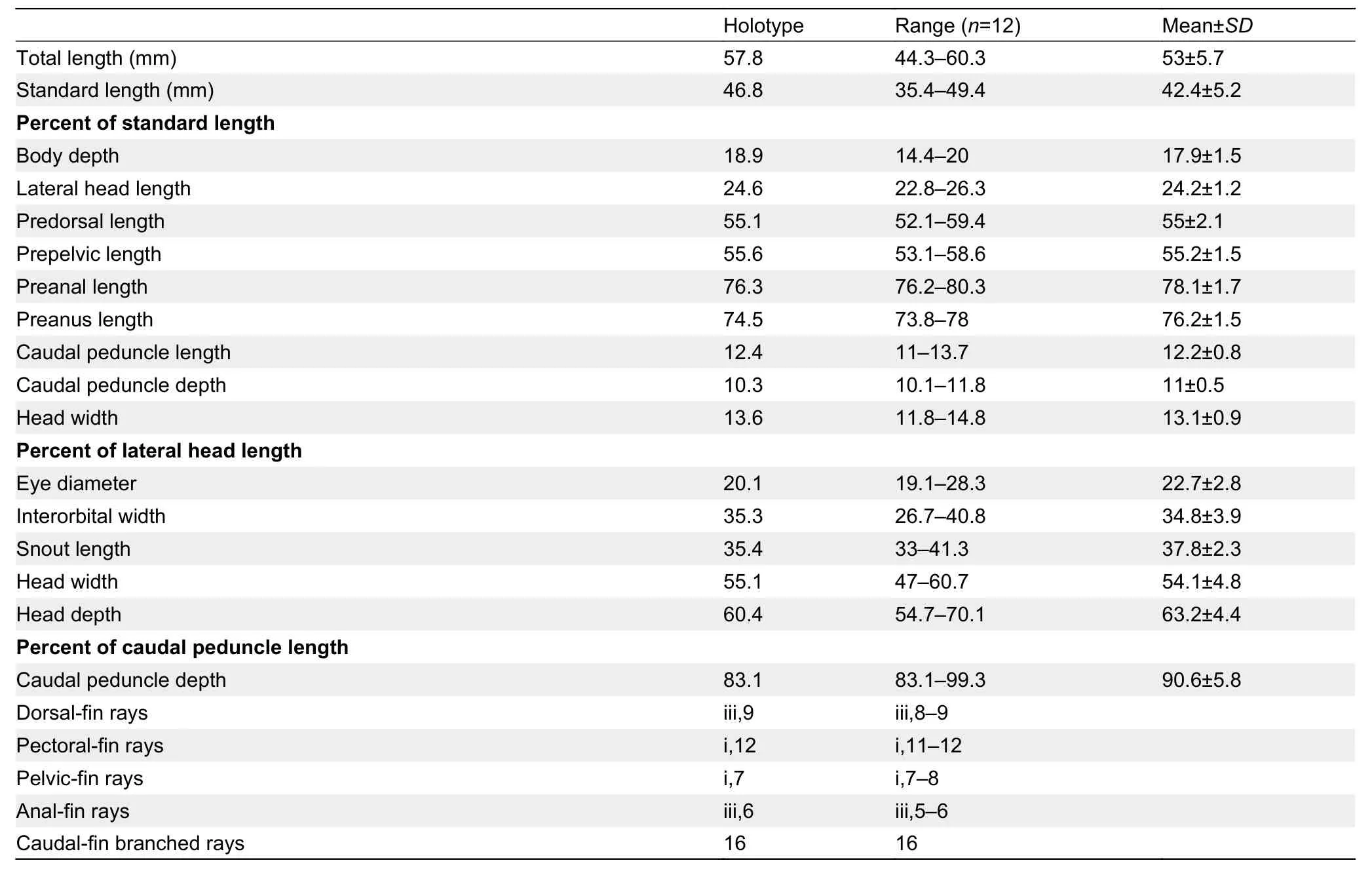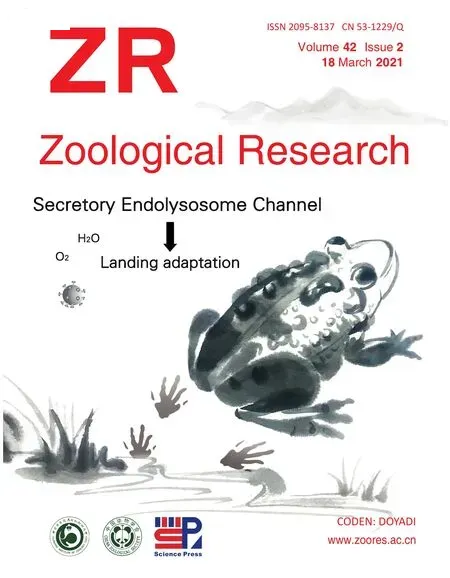Yunnanilus chuanheensis, a new loach species(Cypriniformes: Nemacheilidae) from the upper Lixianjiang River in Yunnan, China
DEAR EDITOR,
A new loach species (Cypriniformes: Nemacheilidae:Yunnanilini),Yunnanilus chuanheensissp.nov., was caught from Chuanhe in the upper reaches of the Lixianjiang River, a tributary of the Red River in Nanjian County, Yunnan Province, China.This species is a member of the traditionalY.pleurotaeniaspecies group based on the presence of a lateral line and cephalic lateral-line canals.It can be distinguished from other species in theY.pleurotaeniaspecies group by the following characters: lips without papillae, anterior and posterior nostrils separated, whole body scaled, eye diameter smaller than interorbital width, outer gill raker absent on first gill arch, eye diameter greater than 18% of head length, 10-11 inner gill rakers on first gill arch, and lateral line not extending to vertical through dorsal fin insertion.To the best of our knowledge, this is the firstYunnanilusspecies recorded from the Red River drainage.
Loaches belong to the suborder (sometimes called superfamily) Cobitoidei within the order Cypriniformes.They are small benthic fish known throughout Eurasia, with high morphological and habitat diversity (Kottelat, 2012).The family-level phylogenetic relationships within Cobitoidei, as well as taxonomic classification and hierarchical relationships at the subfamily, tribe, and genus level, have been frequently discussed, but remain unresolved (see Kottelat, 2012;Prokofiev, 2010).The subfamily Nemacheilinae, which is mainly distributed in China and Southeast Asia, is one of the most diverse lineages of the superfamily Cobitoidei (Freyhof &Serov, 2001).It is also one of the most taxonomically complex groups, with poorly studied systematic and phylogenetic relationships (Prokofiev, 2010).
Loaches in Yunnanilini, also known as theYunnanilusgroup(sensu Prokofiev, 2004), represent a Nemacheilinae tribe(erected by Prokofiev, 2010) that includes eight nominal generic taxa (YunnanilusNichols, 1925;EonemachilusBerg,1938;MicronemacheilusRendahl, 1944;ParanemachilusZhu,1983;HeminoemacheilusZhu and Cao, 1987;PetruichthysMenon, 1987;ProtonemacheilusYang and Chu,1990; andTraccatichthysFreyhof and Serov, 2001).Yunnanilini is characterized by several features: i.e., bony capsule of the swim bladder is open posteriorly, swim bladder is stretched in part, pre-ethmoid-I is present, pelvic fin contains three radials, occipital part of the skull is not elongated, scale cover is well developed, and abdominal axillary lobe is not well developed (Prokofiev, 2010); however,the inter-generic diagnostic characteristics are debatable, and the phylogenetic relationships, especially the validity of some nominal genera, remain unclear.
Yunnanilus, the type genus in Yunnanilini, has 38 nominal species, including 34 species considered valid according to FishBase (Froese & Pauly, 2019).Yang & Chen (1995)previously dividedYunnanilusinto theY.nigromaculatusandY.pleurotaeniaspecies groups based on the absence or presence of lateral lines and cephalic lateral-line canals,respectively.Species described since have usually been assigned to either group according to their combination of diagnostic characters.According to the species descriptions and validities so far, those belonging to theY.nigromaculatusspecies group includeY.altus,Y.bailianensis,Y.bajiangensis,Y.caohaiensis,Y.longibarbatus,Y.longidorsalis,Y.niger,Y.nigromaculatus,Y.niulanensis,Y.obtusirostris,Y.pachycephalus,Y.qujinensis, andY.yangzonghaiensis.Correspondingly, all other species inYunnanilusbelong to theY.pleurotaeniaspecies group.
During an ichthyological sampling of the Lixianjiang River(upper Red River) drainage by the first two authors, several loach specimens were collected.The specimens showed typical characters resembling the genusYunnanilus, including an inferior mouth, separated anterior and posterior nostrils,and tube-like anterior nostrils that were not elongated into a barbel-like structure.Through morphological and molecular examination of the specimens, we identified a new species in theY.pleurotaeniaspecies group, described herein asYunnanilus chuanheensissp.nov.
Specimens were first preserved in 10% formalin then transferred into 75% alcohol and deposited in the Kunming Natural History Museum of Zoology, Kunming Institute of Zoology (KIZ), Chinese Academy of Sciences.Measurements and counts were taken point-to-point with a digital caliper (0.1 mm precision) on the left side of the fish whenever possible.Methods of counts and measurements followed Chu & Chen(1989).The table of morphometric and meristic data followed Du et al.(2015).
To evaluate the genetic distance between the new species and its congeners and to test its phylogenetic position, the mitochondrial cytochrome b (cytb) gene was sequenced from one individual (GenBank accession No.: MW574952).All cytbsequences inYunnanilusdeposited in NCBI were downloaded as background information for molecular analysis.Interspecific pairwise genetic distances were calculated using Kimura’s two-parameter (K2P) model (Kimura, 1980) in MEGA X (Kumar et al., 2018), and a simple maximum-likelihood (ML)tree was constructed to illustrate the phylogenetic relationships using the general time reversible (GTR) model as the best substitution model in MEGA X.
Taxonomy
Yunnanilus chuanheensis sp.nov.Jiang, Zhao, Du &Wang
http://zoobank.org/A7398CE3-7F29-458B-A928-1932719 35C6E
Figure 1A-G; Table 1.
Holotype:KIZ 2 016 007 379, 46.8 mm standard length (SL);China, Yunnan Province, Nanjian County, Baohua Town;Chuanhe, upper reaches of the Lixianjiang River, a tributary of the Red River (N24°52′07.2″, E100°28′09.6″; ~1 844 m a.s.l.);28 April 2016; Wan-Sheng Jiang, Ya-Peng Zhao, and Shu-Sen Shu col.
Paratypes:KIZ 2 016 007 380-90, 11, 35.4-49.4 mm SL,same data as holotype.Tissues of the pectoral fin (right side)of some specimens were taken for DNA sequencing.
Diagnosis:The new species belongs to theY.pleurotaeniaspecies group and is distinguished from theY.nigromaculatusspecies group based on lateral line and cephalic lateral-line canals present (vs.sensory canals absent).For the other species within theY.pleurotaeniaspecies group,Yunnanilus chuanheensissp.nov.can be distinguished from: (1)Y.cruciatusandY.pulcherrimusby papillae on lips absent (vs.present); (2)Y.jinxiensisby anterior and posterior nostril separated (vs.closely placed); (3)Y.analis,Y.beipanjiangensis,Y.chui,Y.discoloris,Y.elakatis,Y.forkicaudalis,Y.macrositanus,Y.nanpanjiangensis,Y.paludosus, andY.sichuanensisby whole body scaled (vs.scaleless or only caudal peduncle scaled); (4)Y.jiuchiensisandY.longibullaby eye diameter smaller than interorbital width (vs.larger); (5)Y.ganheensis,Y.macrolepis, andY.spanisbripesby outer gill raker on first gill arch absent (vs.present); (6)Y.macrogasterby eye diameter greater than 18% of head length (vs.smaller than 12%); (7)Y.parvusby 10-11 inner gill rakers on first gill arch (vs.8-9); and (8)Y.pleurotaeniaby lateral line not extending to vertical through dorsal fin insertion (vs.extending to).
Description:Morphometric and meristic data are presented in Table 1.Body slender.Anterior part of body to dorsal-fin origin cylindrical; caudal peduncle laterally compressed; deepest body depth usually at point anterior to dorsal-fin origin.Head depth greater than width.Snout length less than or equal to postorbital length.Anterior and posterior nostrils widely separated, anterior nostril with fleshy flap forming tube at tip.Eyes normally developed, middle of lateral head length; eye diameter smaller than interorbital width, interorbital space slightly convex.Mouth inferior.Upper lip smooth with wrinkle but no papillae; lower lip with median incision, two lobes on each side.Processus dentiformis absent.Three pairs of barbels; inner rostral barbel reaching to posterior nostril; outer rostral barbel reaching to anterior margin of eye; maxillary barbel reaching to posterior margin of eye.
Dorsal-fin rays iii, 8-9; anal-fin rays iii, 5-6; pectoral-fin rays i, 11-12; pelvic-fin rays i, 7-8; branched caudal-fin rays 16;outer gill rakers absent, inner gill with 10-11 rakers on first gill arch.Lateral line incomplete, extending through to vertical at end of pectoral-fin but not to insertion of dorsal fin.
Dorsal fin truncate, insertion slightly anterior to vertical through pelvic fin insertion, closer to caudal-fin base than to snout tip.Anal fin truncate, tip close to caudal-fin base.Pectoral-fin length half of distance between pectoral- and pelvic-fin origins when adpressed.Pelvic-fin origin slightly posterior to vertical through dorsal-fin origin, closer to anal-fin origin than pectoral-fin origin.Tip of pelvic fin not reaching anus when adpressed.Anus closer to anal-fin origin than posterior insertion of pelvic fin.Caudal peduncle length slightly greater than depth.Caudal fin emarginated.
Body trunk covered with scarce scales, except on ventral area between pectoral and pelvic fins.Air bladder with two chambers; anterior chamber enclosed in bony capsule,posterior chamber large and oval, filling body cavity freely to pelvic-fin origin; anterior and posterior chamber contacted by slender tube, about half length of posterior chamber length.Stomach “U” shaped; intestine straight.
Coloration:In life: both sexes, body brown to grayish yellow,with large brown blotches irregularly distributed on dorsal and lateral body, connected to longitudinal black stripe on lateral line (more distinct in males than females, Figure 1A, C).Inbreeding season, males usually with elongated and subacute pectoral fins and tubercles on caudal peduncle (Figure 1A).Ventral surfaces of head and body light flesh white.Fins hyaline.In 75% ethanol: lateral stripe somewhat faded,brown blotches maintained, body generally light yellow(Figure 1B, D).

Figure 1 Type photo, habitat, distribution, and phylogenetic position of Yunnanilus chuanheensis sp.nov.
Distribution and habitat:Specimens were collected from Chuanhe in the upper reaches of the Lixianjiang River, a tributary of the Red River basin (Figure 1F).The type locality at the time of capture (dry season) consisted of clear and slow-flowing water, with a sand- and cobble-covered bottom and water depth mostly less than 1 m.The banks were fullycovered with secondary forest, mostly shrubs (Figure 1E).Another Nemacheiline loach,Schistura fasciolata, was the only species collected syntopically with this new species.

Table 1 Morphometric and meristic data of Yunnanilus chuanheensis sp.nov.Range, mean, and standard deviation (Mean±SD) include holotype values
Etymology:The name of the new species,chuanheensis, is derived from the Chinese name of the locality river, Chuanhe(川河), and therefore the Chinese name of this new species is"川河云南鳅".
Phylogenetic relationships within Yunnanilus:So far, only 11 nonredundant cytbsequences are available from NCBI with names attributable toYunnanilus.We downloaded these sequences (some extracted from mitochondrial genomes) and reconstructed a preliminary guide tree usingS.fasciolataas the outgroup.The pairwise genetic distances betweenYunnanilus chuanheensissp.nov.and other nominalYunnanilusspecies ranged from 1.3% to 22.8%.The phylogenetic tree further confirmedYunnanilus chuanheensissp.nov.as a member of the genusYunnanilus(Figure 1G).
Remarks:Although the division ofYunnanilusinto theY.nigromaculatusandY.pleurotaeniaspecies groups by Yang &Chen (1995) has facilitated taxonomic studies, this classification system has not yet been tested due to very limited molecular information.Kottelat (2012) assumed thatYunnanilusis not a monophyletic group, and placedY.longidorsalis,Y.nigromaculatus, andY.yangzonghaiensisintoEonemachilusbased on their terminal mouths and color patterns.Kottelat (2012, 2013) also placedY.altus,Y.analis,Y.caohaiensis,Y.niger, andY.obtusirostrisintoHeminoemacheilus,Y.brevisintoPetruichthys,Y.pulcherrimusandY.chuiintoMicronemacheilus, andY.cruciatusintoMicronemacheilusbut without providing any substantial arguments for these classifications.
The phylogenetic tree (Figure 1G) reconstructed in this study, although preliminary, reflects that the inner relationships ofYunnanilusare indeed complicated.For instance, the genetic distances betweenYunnanilus chuanheensissp.nov.and other nominalYunnanilusspecies fell within a very wide range, from 1.3% to 22.8%.Interestingly, both the minimum-distanced (Y.sp.KX-2017,1.3%) and maximum-distanced species (Y.sichuanensis,22.8%) fromYunnanilus chuanheensissp.nov.were from Sichuan Province.Additionally, the other genera removed fromYunnanilusby Kottelat (2012), such asY.(Micronemacheilus)cruciatusandY.(Petruichthys)brevis,were mixed within the remainingYunnanilusaccording to the present tree.This further suggests that a comprehensive molecular phylogenetic tree is urgently required to uncover the inner relationships of theYunnanilusgroup.However, this is beyond the scope of the current study.
NOMENCLATURAL ACTS REGISTRATION
The electronic version of this article in portable document format will represent a published work according to the International Commission on Zoological Nomenclature (ICZN),and hence the new names contained in the electronic version are effectively published under that Code from the electronic edition alone (see Articles 8.5-8.6 of the Code).This published work and the nomenclatural acts it contains have been registered in ZooBank, the online registration system for the ICZN.The ZooBank LSIDs (Life Science Identifiers) can be resolved and the associated information can be viewed through any standard web browser by appending the LSID to the prefix http://zoobank.org/.
Publication LSID:
urn:lsid:zoobank.org:pub: 94F2E4C4-F763-4378-BB05-BC854 A369D6D.
Nomenclatural act LSID:
urn:lsid:zoobank.org:act: A7398CE3-7F29-458B-A928-19327 1935C6E.
SCIENTIFIC FIELD SURVEY PERMISSION INFORMATION
The collection of fish used in this study complied with the Wildlife Protection Act of China.Permission for field survey in Baohua Town was approved by the Nanjian Bureau of Wuliangshan National Nature Reserve.
COMPETING INTERESTS
The authors declare that they have no competing interests.
AUTHORS’ CONTRIBUTIONS
W.S.J.and Y.P.Z.collected the fish.W.S.J.and M.W.designed the study.W.S.J., Y.P.Z., and L.N.D.examined the fish.Y.P.Z.and L.N.D.performed morphological comparisons.W.S.J.conducted molecular analysis.W.S.J., Y.P.Z., and M.W.wrote the draft.All authors read and approved the final version of the manuscript.
ACKNOWLEDGMENTS
We are grateful to Dr.Jun-Xing Yang (KIZ) for his full support during this work.We also thank Ms.Hui-Ju Li (Nanjian Bureau of Wuliangshan National Nature Reserve) and Dr.Shu-Sen Shu (KIZ) for collecting and Ms.Rui Min (KIZ) for examining the specimens.
- Zoological Research的其它文章
- Flexible breeding performance under unstable climatic conditions in a tropical passerine in Southwest China
- Comparative transcriptomics highlights convergent evolution of energy metabolic pathways in group-living spiders
- Long-term trends in a forest ungulate community: park establishment increases numbers, but poaching is a constant threat
- Molecular phylogeny of the genus Muntiacus with special emphasis on the phylogenetic position of Muntiacus gongshanensis
- Parasitism is always costly to the host
- A new species of the genus Micryletta (Anura,Microhylidae) from Hainan Island, China

